M. Isidora Forrest's Blog, page 13
August 20, 2023
What is the Mensa Isiaca?

Have you ever heard of the Mensa Isiaca?
Did this mysterious Isiac artifact serve as the altar when Plato received his initiation into the Egyptian Greater Mysteries in a secret, subterranean hall beneath the Great Pyramid? Was it an altar top from a Roman Temple of Isis? Was it a repository of ancient occult lore? A key to the hieroglyphs? Or the tarot? Perhaps it was just a rather expensive piece of home decor for a rich Roman with a penchant for Isis?
All of these things have been suggested as the ultimate identity of this significant Isiac artifact. It has quite the history…and some legit mysteries, all of which we take a look at as we try to find out more about this literally unique artifact—and discover what it has meant in the long story of the worship of our Goddess Isis.
As you may have guessed, “Mensa Isiaca” is Latin. It means “Table (or Tablet) of Isis.” It’s also known as the Bembine Table of Isis. I’ll explain why in a bit.
 One of the prizes in our library, a copy of one of the few works about the Mensa Isiaca. The author is W. Wynn Westcott, one of the three founders of the Hermetic Order of the Golden Dawn.
One of the prizes in our library, a copy of one of the few works about the Mensa Isiaca. The author is W. Wynn Westcott, one of the three founders of the Hermetic Order of the Golden Dawn.First, what is it?
The Mensa Isiaca is a large bronze tabletop inlaid with polychrome metals—that is, a variety of colored metals—featuring Egyptian figures in a selection of typical Egyptian-style poses, all surrounding the central, enshrined figure of Isis. Or at least She has always been taken to be Isis due to the popularity of the Goddess during the period of the Mensa’s creation, sometime between the 1st century BCE and the 1st century CE. And it was almost certainly made in Rome.
The reason we cannot be absolutely sure the central figure is Isis is that, while the Mensa includes hieroglyphs, they are only pseudo-hieroglyphs and cannot be read. They are decoratively placed near the figures, as well as around the lip of the Mensa and the borders that separate its three surface registers. So, unfortunately, they cannot help us clearly identify the figures on the Mensa. The Mensa’s later interpreters, however, did not know this and spent a good deal of brainpower on trying, unsuccessfully, to decipher the glyphs.
The art style is all very Egyptian, in the Hellenistic mode. In other words, the images look very much like the ones found in many of the Hellenistic-era temples we see in Egypt today. It’s that slightly softer style you see at Denderah rather than the older, crisper style at Abydos.
But before we go further, you may be wondering what the Mensa Isiaca looks like; click for a larger image:
 The Mensa Isiaca; I know, it’s hard to see, so there’s an illustration later in the post. As you may have guessed, that’s Isis in the middle.
The Mensa Isiaca; I know, it’s hard to see, so there’s an illustration later in the post. As you may have guessed, that’s Isis in the middle.I hadn’t remembered how large the Mensa Isiaca was until I read a recent article with results from an intensive study of the Mensa while it was on loan from Italy’s Turin Egyptian Museum to the Getty Museum in L.A. At almost 50 inches wide (126 cm) and 30 inches tall (75.5 cm), it is decidedly table-sized rather than tablet-sized. It also has a slightly-over-2-inch lip on all sides of the table. I had been picturing it as something a bit more portable. But no. It’s of an impressive size as well as being an impressive work of art.
While at the Getty Museum, researchers took advantage of new technologies that enabled them to study the Mensa Isiaca in new depth and non-invasively.
 Examples of Egyptian polychrome metalwork; note the inlaid gold, silver, and copper
Examples of Egyptian polychrome metalwork; note the inlaid gold, silver, and copperA striking feature of the Mensa is its polychrome inlays. Earlier in the Mensa’s history, some of the more colorful inlays had been described as enamel. Others suggested that the beautiful variety of colored metals were the result of Egyptian alchemical experiments. Researchers found that the metalsmiths used at least seven distinct alloys, including silver, gold, black bronze, and a variety of different copper and zinc alloys. They achieved colors from red, yellow, orange, and brown to blue-grey. Each figure is intricately outlined in silver or black bronze wire. The Mensa is in remarkably good shape and shows no signs of ever having been buried. In other words, it has remained in someone’s hands throughout its lifetime.
 An illustration of the Mensa Isiaca so you can more easily see the imagery; click to enlarge
An illustration of the Mensa Isiaca so you can more easily see the imagery; click to enlargePolychrome metalwork was a specialty of Egyptian craftspeople; we have examples from at least the 18th dynasty and researchers now think the technique was much more widespread than they had previously believed. Thus, the Mensa Isiaca was created using techniques that were genuinely Egyptian—even if the craftspeople didn’t know hieroglyphs (many didn’t by that time). Due to the excellence of the work and Egyptian mastery of those techniques, my guess is that is was created by Egyptian metalsmiths working in Rome, perhaps with Roman smiths. But we have no proof. It could also have been made by Roman smiths in an Egyptianizing style.
 A closeup of some of the complex metalwork on the Mensa
A closeup of some of the complex metalwork on the Mensa
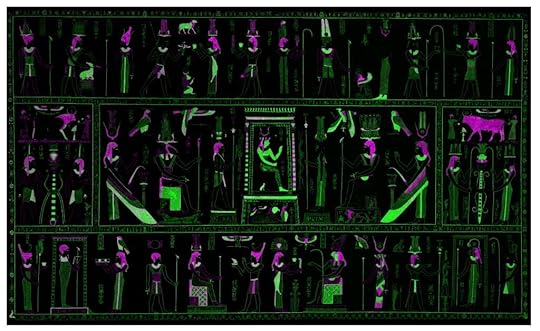 The green represents where silver was used; the purple represents gold
The green represents where silver was used; the purple represents goldIf you’d like to read all the details about the Getty investigation into the physical properties of the Mensa Isiaca, here’s the link. (Most of the images in this post are from this article.)
What is its history?
 Cardinal Bembo
Cardinal BemboThere is no historical mention of the Mensa Isiaca until after the sacking of Rome in 1527. Some of the unpaid-for-a-long-time forces of the Holy Roman Emperor, Charles V, overran the city of Rome and went on a rampage of destruction, looting, and killing.
The Mensa was likely kept in one of Rome’s palaces prior to the sacking. Afterwards, it came into the hands of a blacksmith or ironworker who eventually sold it to Cardinal Bembo—after which it was known as the Bembine Table (or Tablet) of Isis. Bembo was an Italian scholar, trained in Neoplatonism and intensely interested in his country’s history. In later life, he was made a cardinal in secret. He is buried in the Santa Maria Sopra Minerva basilica, part of which lies over the older Temple of Isis in the Campus Martius.
The Mensa remained in Bembo’s hands until after his death. Then, it came into the possession of the Dukes of Mantua, who kept it in their museum until 1630, when Mantua was besieged and also sacked. We don’t know how, but it next came into the hands of Cardinal Pava, who gifted it to the Duke of Savoy, who eventually gave it to the King of Sardinia in 1730. In 1797, French troops brought it to Paris, where it was exhibited in the Bibliothèque Nationale. With peace between France and Italy, it was returned to Turin. Today, Turin is the site of Italy’s Museo Egizio (Egyptian Museum) and the permanent home of the Mensa Isiaca.
 Proposed original appearance of the central register with Isis, digitally recreated except for missing or damaged areas
Proposed original appearance of the central register with Isis, digitally recreated except for missing or damaged areasIn Westcott’s book about the Mensa (see the image above), he notes that a guidebook for travelers to northern Italy by John Murray, published in 1863, mentions the Mensa and gives an unattributed history. Murray says that the Mensa was originally found on Mount Aventine in Rome where once stood a temple of Isis and suggests it was made during the reign of Emperor Hadrian. This period for its creation is entirely possible since Hadrian’s reign roughly matches the current scholarly dating for the Mensa Isiaca—and Hadrian himself was quite the Egyptophile. As far as I can tell, none of the known Isis temples in Rome was on the Aventine hill. But then, much of the Aventine is unexcavated since it is covered with many homes.
What is the Mensa Isiaca’s occult significance?
That’s enough of historical history (as far as we know it) for now. Its occult history is much more interesting. The Mensa Isiaca has been an inspiration to occultists for centuries and was believed to contain the deep secrets of ancient Egyptian mysteries and magic. We’ll get into that fascinating subject next time in Part 2.
August 13, 2023
She is Rising 2023

For me, there are two things that make August wonderful, here in Portland, Oregon. One of them is all the produce that I can go pick on Sauvie’s Island, fresh from the farmers’ fields. (My countertops are full of peaches and tomatoes right now and peppers are on the way.) The other—and the more important for us local Isiacs—is the heliacal rising of the Star of Isis, Sirius.
While everything else starts to crisp in the late-summer heat, I am refreshed in the cool morning of Her rising power.
Now some of you may be saying, “wait, wait, I thought that happens in July.” It could. When you are able to see Her heliacal (“before the sun”) rising depends on where on this globe you are.
Here in Portland, Oregon in 2023, Sirius rises at 4:31 in the morning, Local Solar Time, of August 23rd. Further south, She rises earlier. It all depends on your latitude. You can calculate Her rising in your area with this online calculator. The calculator results are in Local Solar Time. It gives you star rise and sun rise in LST.
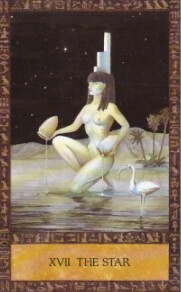 One of my favorite tarot images: Isis as The Star in the Ancient Egyptian Tarot by Clive Barrett
One of my favorite tarot images: Isis as The Star in the Ancient Egyptian Tarot by Clive BarrettThere is some difference between clock time and Local Solar Time. But check the time of sunrise locally and you can work backward from there. In my case, I’ll want to be at my point of observation about 5:30 in the morning, about an hour before local sunrise. And this year, for once, it may be clear enough to see Her rise.
While Isis has connections to both the sun and the moon, the heavenly body in which I most easily see Her is the star, Her star: Sirius (Sopdet in Egyptian, Sothis in Greek). And it isn’t just because of Her strong ancient connections with the Fair Star of the Waters, the Herald of the Inundation. It’s something about the way my particular spiritual “stuff” fits with Her particular Divine “stuff.” Her diamond starlight draws me, lures me, illuminates my heart and mind.
 The Star of Isis, coming soon to a dawn near me
The Star of Isis, coming soon to a dawn near meI fell in love with Her as Lady of the Star the first time I saw Sirius through a telescope. As I watched, Her brilliant star sparkled with rays of green and blue and pink and white. It was incredibly, unutterably beautiful. It was alive. And pure.
Likely, you already know why Sirius was important to the ancient Egyptians, so I won’t repeat that here. But I would like to add a few interesting bits about Sirius that you may not know about; in particular, the orientation of some Egyptian temples and shrines to Sirius at the time of their construction. For instance, the small Isis temple at Denderah and Isis’ great temple at Philae seem to have been oriented toward the rising of Sirius. Philae may even have a double stellar orientation: one axis to the rising of Sirius, one to the setting of Canopus.
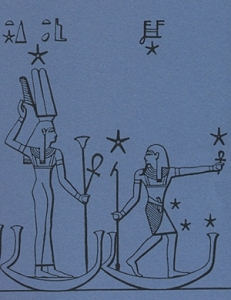 Iset-Sopdet following Sah-Osiris in Their celestial boats
Iset-Sopdet following Sah-Osiris in Their celestial boatsOverall, Egyptian temples have a variety of orientations. A survey of temples taken between 2004 and 2008—that actually went to the temples in Egypt and measured the orientation—showed that most temples were oriented so that the main entrance faced the Nile. But not only that. It seems that the temples were also oriented toward other astronomical events, most especially the winter solstice sunrise, which of course makes very good sense as a symbol of rebirth.
Orientation to Sirius is rarer and harder to be certain of since the earth’s position in relation to the stars has shifted over the millennia.
A Horus temple, called the “Nest of Horus” on the summit of the highest peak of the Hills of Thebes, seems to have been oriented to the heliacal rising of Sirius around 3000-2000 BCE. Nearby, an inscription carved in rock during the 17th dynasty (1580-1550 BCE) records the observation of just such a rising of Sirius. This high place would have been ideal for Horus in His nest to await the coming of His mother Isis. On the other hand, the archaeoastronomers who did the survey I mentioned believe that it may also be oriented to the winter solstice sunrise, an event closely associated with Horus.
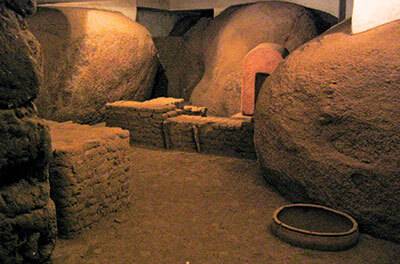 The original temple of Satet on Elephantine; made of mudbrick nestled among the natural boulders
The original temple of Satet on Elephantine; made of mudbrick nestled among the natural bouldersAnother temple that may have a Sirius orientation is the archaic temple of the Goddess Satet on the island of Elephantine. The original temple was built amidst the great boulders on the island and really is quite simply the coolest temple ever. It seems that when it was built (around 3200 BCE) the rising of Sirius and the rising of the winter solstice sun were at the same place—so it could have been built to accommodate both important astronomical events.
After the initial study, the same team followed up with a survey (in 2008) of some temples in the Fayum that they hadn’t been able to study before as well as temples in Kush. They found generally the same results except for the Nile orientation since many of these temples were built far away from the river. They made note of a son of a Priest of Isis, Wayekiye, son of Hornakhtyotef, who was “hont-priest of Sopdet” and ”wab-priest of the five living stars” (the planets) and “chief magician of the King of Kush.” This is from an inscription on Isis’ temple at Philae dating to about 227 CE. It emphasizes the importance and sacrality of the study of celestial objects and events to the kingdom and it is quite interesting that this was the work of the Chief Magician. This study revealed that most Kushite temples and pyramids were oriented either to the winter solstice sunrise or the rise of Sirius.
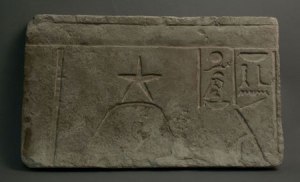 The star Sopdet over the head of the Goddess
The star Sopdet over the head of the GoddessAnother interesting thing the study found was that by the time of the New Kingdom, in the 34 temples that were unmistakably dedicated to a Goddess—specifically Isis or a Goddess associated with Her—the most important celestial orientation point was the rising of Sirius. But, in addition to Sirius, the star Canopus was also a key orientation point. According to their data, Goddess temples in general were more frequently aligned with these very bright stars, Sirius and Canopus, while God temples were more often oriented to key solar-cycle events. Isn’t that interesting?
 On the horizon, She rises, with Orion/Osiris above
On the horizon, She rises, with Orion/Osiris aboveIf you are, as I am, feeling the anticipation of Her rising later this month, you might like to do some ritual. The Opening of the Ways is always good. You could use it as an invitation to Her. Or try a simple meditation, allowing yourself to yearn for Her coming. Waiting for Her and wanting Her is sometimes a very good exercise. You might set out a vessel of water (a shiny silver one is nice) on the night of Her rising, let it be charged with that rising energy in the dawn, then use it as part of your holy water for purification. I have just such star water that I use waiting in my shrine right now.
August 6, 2023
Isis & the Soul, Pt 2
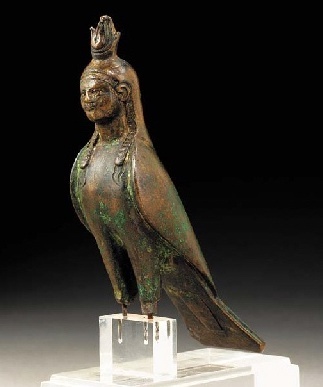 A beautiful, bronze ba statue
A beautiful, bronze ba statueLast time, we talked about the Egyptian ba—very loosely translated as the soul. When represented in tombs, the ba is shown as a human-headed bird, often a falcon or hawk, and bearing the face of the person to whom it belongs.
With their power of flight, birds have always been magical creatures to us flightless human beings. Not only in Egypt, but in many cultures throughout the world, birds of various types have been associated with death and the afterlife. In some cases, birds (especially the owl) are seen as harbingers of death. Sometimes, birds are psychopomps, guides of the dead, showing the newly-disembodied human soul or spirit the correct path to the Otherworld. Researchers have suggested that the concept of birds as spirits of the dead that have returned to earth is almost universal.
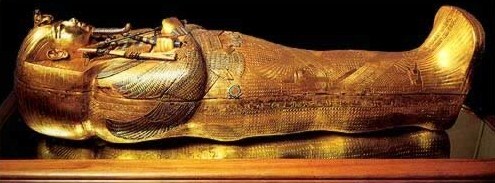 Tutankhamon’s innermost sarcophagus, aka “the egg”
Tutankhamon’s innermost sarcophagus, aka “the egg”But more often than being harbingers of death, birds are associated with the idea of transcendence and rebirth, as they decidedly were in ancient Egypt. The innermost coffin was sometimes referred to as “the egg,” so you can see the power of this idea almost immediately. In the funerary literature, we also find birds in connection with the so-called “transformation” spells, which are designated in the texts by the verb kheper, “to become.” So once again, we come to that important word.
 Two forms of Isis from Denderah: anthropomorphic and in Her Ba form
Two forms of Isis from Denderah: anthropomorphic and in Her Ba formAs you already know, our Goddess Isis is often depicted in birdform. She is the hawk, falcon, kestral, or swallow protecting the body of Osiris, and thus all the dead, with Her powerful wings. But sometimes, She is also shown as a human-headed falcon. In this case, we are being shown Her powerful ba kheper. If you recall last week’s post, you’ll remember that in the earliest Egyptian records, the ba is a Divine Force. That Divine Force is what we are intended to see when we find Isis in this form. It is Her Great Ba that is with us.
From an inscription at Denderah, we are told that Isis is “She Whose Ba (-Power) is Great” and “She Whose Ba is Great Among the Gods,” and even “She Whose Ba is Greater Than All the Gods.” Human beings recognize the power of Her ba: “those on earth bow to Her Ba.” (And, it is often the ba of the Deity that was understood to inhabit the Deity’s sacred image; sometimes the ka, too, but mostly the ba.)
Isis is also among the Great Goddesses Who are called Ba-et Goddesses. As a Ba-et Goddess, Isis’ ba-power is understood to be exceptionally powerful among the bau (plural) of all the other Deities. Isis is “She Who is More Mighty (Ba-et) than the Gods.” She is especially powerful in the sky: She is “The Mighty One (Ba-et) in the Sky,” “The Mighty One in the West and the East,” and She is “The Mighty One of the Bau Souls.”
 I don’t know how to attribute these AI illos, but this one gets something of Her power; here’s the link
I don’t know how to attribute these AI illos, but this one gets something of Her power; here’s the linkThis last title likely refers to Isis’ status among the Deities—a Great Ba among Great Bau. But I wonder if we might also take it as a reference to Her care of the human bau, souls, who are under Her wings.
It is Isis Who initiates the human ba into its new, transformed existence without the living body of the deceased. She is the Lady of All in the Secret Place—the Otherworld—and She is asked by the deceased in the Coffin Texts to, “spiritualize me, O You who split open my mouth for me and Who guide my soul on the paths of the Otherworld.” We are told that “Isis rejoices when She sees you (the deceased)” in the Otherworld and reciprocally, that the dead (as Osiris) rejoice when they see Her, for they know they can count on Her help in their renewal.
 Isis in protective posture
Isis in protective postureIsis also bestows upon the deceased power and awe so that enemies of the decease are easily fended off. The dead are told that they are possessors of “the fear (awe or power) that went forth from Isis to Horus.” While the texts do not explicitly say so, it seems to me that Isis may have endowed the deceased with some of Her powerful and “awe-full” ba-power. In another Coffin Text, the deceased is told that “the power of Isis is your strength” and that the dead one is “more spirit (akh)-like and more soul (ba)-like” than the Southern or Northern Gods.
 From Pompeii, a Mystery fresco
From Pompeii, a Mystery frescoIsis’ concern with souls continued as Her worship entered the Graeco-Roman world. She becomes known as a Mystery Goddess—and the Mysteries were always about the Mysteries of death, rebirth, and often, the saving of souls. In Isis’ famous Mysteries, initiates learned what lay before them in the afterlife so that they lost their fear of death and could live more fulfilling lives on earth. In fact, Isis was specifically known as a Savior Goddess, which not only pertains to Her ability to initiate our souls into the Mysteries of Death and Rebirth, but also to Her saving grace in our day-to-day lives.
In a Hermetic treatise, the Kore Kosmou (“Virgin of the Universe”), Isis continued to be associated with souls. (Read more about the Kore Kosmou here, and here, and here.)
 The always Mysterious sphinx
The always Mysterious sphinxIn this text, Isis describes for Horus how human souls were created and how She and Osiris devised the “magic of the prophet-priests” so that our souls could be nurtured by philosophy and our bodies could be healed by the magical arts. Other Hermetic texts depict Isis teaching about reincarnation and the true nature of our souls.
From the earliest to the latest periods, Isis has been the Lady of Souls. She has, and is, an extremely powerful ba Herself and always, always maintains Her concern with and knowledge of souls.
July 30, 2023
Isis & the Soul

What is your concept of the soul?
It’s one of those things that we often talk about, but we don’t have a firm definition of what, exactly, it is. Is it the divine part of ourselves? Is it the immortal part that survives after death? Is it some kind of “essence” of ourselves? Is it our inner life, our thoughts, feelings, passions? Do only human beings have one, or do other beings and things have one, too? Is it what animates us, what makes us alive? In Latin, the word for soul is anima and modern languages like French and Spanish have words for soul (âme and alma) that come directly from Latin.
The English word derives from Old English sawol and is related to a number of similar old-European words. Psychology, the study of the psyche—Greek for soul—thus involves the study (or literally, “speaking about,” –ology) the soul. So psychologists and psychotherapists are concerned with healing the soul.

Most people, throughout the world, have some sort of concept of something like the soul. Yes, of course, the ancient Egyptians did, too. And yes, of course, Our Lady Isis has an intimate concern with souls.
Those of you who have been reading this blog probably already know that the ancient Egyptians did things a little differently. And you may already know that they had a broader concept of what goes into making up the full nature of the human being. These are words like ka, ba, akh, khat, ren, ib, and shadow. We find these terms numbering from about five on the low end to about sixteen on the high end. Often, you will see them referred to as “components” or “parts” of the human being, both in life and afterlife. That’s not quite right, so more-modern scholars will call them “aspects” of the human being. This is much closer.
 The ba-bird and the shadow of the deceased
The ba-bird and the shadow of the deceasedBut I just learned today, that there is an Egyptian word that is not only appropriate and which at least some learned Egyptians seem to have used as the collective term for these aspects. The word is kheperu.* It means “forms, transformations, manifestations” and oh-so-much more. It is found in the name of the Sun Scarab God, Khepri or Khepera. As a verb, it means “changing, transforming, becoming.” The root also has to do with creation, birth, and rebirth.
What I learned is that in some examples of the funerary literature, you will see a list of the familiar aspects of the human being, but with the word kheperu at the end. Scholars think that the word kheperu—transformations—at the end was meant to sum up all the preceding aspects. Why is this important? Because it confirms that the kheperu of a person should not be understood as discreet or disjointed “parts” of the human being. But rather that the ancients understood them to be forms or ways of being that the human being could transform into during different aspects of their life/afterlife journey.
Today, I’d like to focus on just one of these kheperu: the ba.
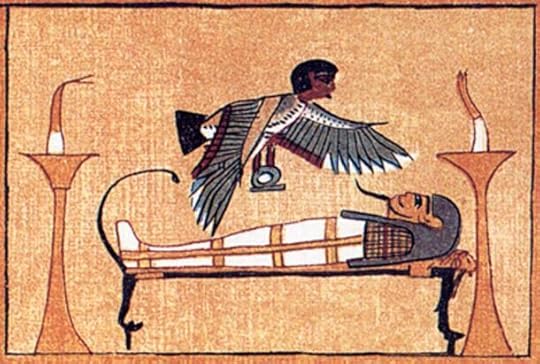 The ba hovers over the body of its deceased
The ba hovers over the body of its deceasedWe have come to use the word “soul” to translate ba because way back in the 4th century CE, a writer name Horapollo (a perfect Egypto-Greek name if ever there heard one) so translated it. Horapollo was a Greco-Egyptian intellectual who wrote a book, in Greek, on the meanings of the hieroglyphs. In addition to giving us the ba = psyche equation, Horapollo also connected the ba with the heart, for, he said, the Egyptians say that the soul resides in the heart.
Here’s Horapollo’s entry on The Soul:
That the hawk is a symbol for the soul is clear from the interpretation of its name. For the hawk is called by the Egyptians Baieth. If this name is divided, it means “soul” and “heart.” For Bai is the soul and Eth is the heart. And the heart, according to the Egyptians, contains the soul. Hence the interpretation of the combined name is the “soul in the heart.” Wherefore the hawk, since it has the same character as the soul, never drinks water, but blood, on which the soul is nourished.
The Hierogliphics, Book I, entry on The Soul
We may also note that in Book II of Horapollo, the symbol for the human soul is a star—as well as a symbol for a Deity, twilight, night, and time, all of which is true enough. Remember that by the 4th century CE, a lot of the traditional knowledge about the sacred writing had been lost. So it’s likely that what Horapollo reports is what was current in his day.
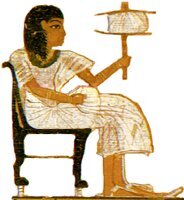 The ba of Shu fills the sail of the deceased with the breath of life
The ba of Shu fills the sail of the deceased with the breath of lifeBa is an extremely complicated concept in ancient Egypt (and don’t get me started on ka!) Like so many other things, it too, changed over the millennia. Scholars are still trying to figure out precisely what it meant. But happily, we do know some things, so we’re not completely in the dark.
In the earliest Egyptian texts, the ba appears to be a Divine force. The word seems to refer to a manifested spirit, usually the manifestation of a Deity. The ba of a Deity could appear as a natural force—the wind is the ba of Shu—or in the form of a sacred animal. For instance, the Apis bull of Memphis was considered the ba of, first Ptah, then Osiris; the Hesis cow, mother of the Apis, was considered the ba of Isis. What’s more, one Deity could be the ba of another. Osiris and Heka are bas of Re; Sothis is the ba of Isis. By the end of the Old Kingdom, the concept of the ba was understood more broadly. Everybody—and some things as well—had one. Post Amarna, every Deity and everything could be considered a ba of Amun/Amun-Re.
 The ba of the deceased perched on a papyrus plant; Ptolemaic era
The ba of the deceased perched on a papyrus plant; Ptolemaic eraWhen it comes to human beings, generally, the ba was thought to be a non-physical aspect of a person that comprised their personality or character. The impression one makes on others is because of the nature of one’s ba. The ba is also a form or manifestation—a kheper—of the human being in the spiritual realm. After death, a human being’s ba could take on super-human power; not as powerful as a Deity’s, but powerful.
In tombs, the ba of the deceased person is usually shown as a human-headed bird, often a hawk like Horapollo says. Sometimes the ba-bird also has human arms and hands. With it’s human face, it is linked to the individual human being and reflects the personality or character of the person. Yet its birdform gives it the ability to move between the worlds. And because it can enter into the spirit world, it knows things beyond normal human knowledge. Thus it can also serve as a counselor to human beings while we are still alive. We have a piece of ancient literature in which a man is in a dispute with his ba over whether or not he should commit suicide. Egyptian wisdom literature also advised people to do good in life in order to feed their bas.
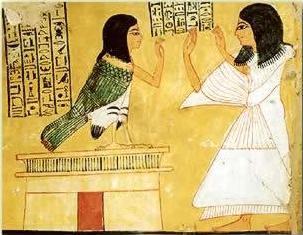 A man and his ba greet and mirror each other in the underworld
A man and his ba greet and mirror each other in the underworldWell. I see that this post has gotten a bit long and I haven’t even brought in Isis, She Who “guides my soul on the paths of the Netherworld.” So we’ll continue this soulful discussion next time and learn the may ways that Isis is connected with the powerful ba.
* In Isis Magic, I use the term Kheperu for the various forms of the Deities as well as the magical technique of “Taking on the God/dessform.”
July 23, 2023
Talking with Isis
 A meditation on beautiful Sirius, the Star of Isis
A meditation on beautiful Sirius, the Star of IsisI was talking, not with Isis, but with a couple priestess friends of mine, last evening at a lovely party we were having. We were talking about our upcoming, local Fall Equinox festival, this year dedicated to Hekate. While I’m not among the main folks in charge, I do have one significant role that includes “talking with Hekate.” I wanted their take on how Hekate “feels” and/or “sounds” when my fellow priestesses connect with Her.
It’s always enlightening and interesting to hear the experiences of others with our Divine Ones. For myself, I will just briefly say that, so far, Hekate feels a bit “heavier” than Isis and has a deeper voice. During one of my first meditations with Her, Isis was there with me, handing me off for a brief time, for this Magical Work with Hekate.
All that said, today I’m cleaning up from last night’s party, so this is a repost about talking with Our Lady Isis. Feel free to add your own experiences in the comments. I’d love to hear them.
*****************************************
When we connect with Isis, how do we do that? Prayer? Meditation? Invocation? Visualization? Can we talk with Her, actually have a back-and-forth conversation? Can we ask Her questions? Can we request Her help?
Yes, we can. But how it happens exactly is different for different people.
My own boundaries between prayer, meditation, and visualization tend to be rather soft. Very often, I find that meditation flows into visualization flows into prayer flows into an offering chant flows back into meditation. Sometimes I visualize the whole time, sometimes I don’t “see” anything, but just feel Her presence. Sometimes I can “hear” Her voice, sometimes I just sense in some way what She is communicating with me.

Here’s a perfect image for ‘ascending’ in your visualizations…indeed, the pillars in Egyptian temples were meant to be holding up the sky.
But why do we talk with the Goddess, why do we strive to “see” Her? There is a point and it’s not just an ego boost.
The point of this sort of talking with the Goddess is communion—sharing with Her in one way or another and asking Her to share with us. Sometimes we just need the reassurance that She is there, so we invoke and try to sense Her. Sometimes we need help, so we ask for it. Sometimes we are so full of love for Her that we simply must express it.
 An excellent posture for meditation
An excellent posture for meditationTalking with Goddess is good for our souls and spirits, too. I think that Iamblichus, my favorite Neoplatonic theurgist, had it right: invocation of the Deities lifts up the soul of the theurgist (or Isis devotee, in this case) and brings us closer to the Divine. By repeatedly connecting with Isis—whether through prayer or ritual or devotions, meditations or visualizations, dance or chanting, or any number of other ways—we make ongoing contact with the Divine.
The more we come into the presence of Holy Isis, the more we become infused with Her holiness. In the same way that we tend to mirror the people with whom we spend the most time, spending more time with the Divine can help us better mirror that Divinity, and can help to make us better people.
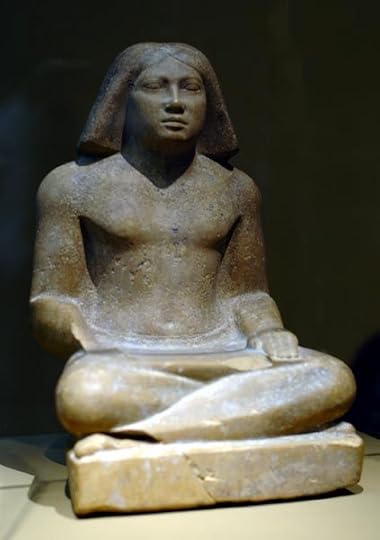 This classic scribe’s posture is perfect for meditation, too
This classic scribe’s posture is perfect for meditation, tooOf course there are ways we can make some serious missteps in this process. The most problematic is when we think we’re talking to Isis, but we’re actually talking to ourselves; when it’s not Isis Who we hear in our heads, but only our own subconscious echoes.
That’s what I think happens with some of the mega-church preachers who always seem to hear God asking for more money or with church-based hate groups who think they hear God condemning everyone but themselves. They’re not talking to the Divine; they’re getting feedback from their own interior bullshit. This can happen to people with even the best of intentions. I know it’s happened to me; chances are, if you’re talking with Isis, it will or already has happened to you, too.
So what do we do about it?
 Sometimes, vision looks like this
Sometimes, vision looks like thisUnfortunately, there’s no easy answer, no perfect solution, no quick fix. The only partial answer that I know of is to develop spiritual maturity. A spiritually mature person will be better able to recognize their own internal “stuff,” and so be better able to separate it from true Divine contact with Isis. Did Isis really say that so-and-so with whom I had a fight yesterday deserved a big, fat comeuppance? Nope; pretty sure that was me and not Her. She, on the other hand, might offer advice on how I can get over it or She might even point out that I need to make an apology.
The other tricky thing about all this is that while we live in these bodies, we will never—I repeat, never—receive pure and unadulterated contact with the Divine. It comes to us though our own perceptions of body, soul, mind, and spirit. There is no other path the Divine can use to reach us. While we are incarnate beings, the Goddess must come to us through our perceptions—and our perceptions are always, always, always tinged by our own psychological makeup. That’s not necessarily a bad thing. In fact, getting to know our own psychology is very valuable in sorting all this out. It’s just something that is and we have to be aware of it if we hope to hear—in the clearest voice possible—what Isis has to say.
 Or like this…
Or like this…The one clue I can offer, after many years of wrestling with my own head and heart, is that when it is truly Her—as opposed to just my echo chamber—the thought-impression-feeling-intuition I get seems to come suddenly and without precedent. I can recognize it as “not-me” (or not just me). Sometimes the words are strange or the images are not ones I would normally choose. Yes, it’s all very subjective—which is my point exactly. That’s why the more you know about yourself, the more you can move yourself out of the way so that you can better know when it is Isis Who is doing the talking.
July 16, 2023
Knot Magic & Isis
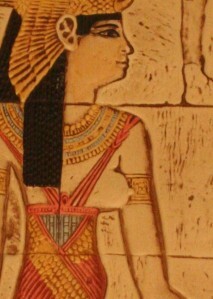 Note the knots in the straps of the Goddess’ garment as well as the little loop between Her breasts.
Note the knots in the straps of the Goddess’ garment as well as the little loop between Her breasts.I am slightly obsessed with knots in Egyptian magic. The basic idea is fairly simple: tied knots bind and untied knots release. Beyond that, knots can unite opposites and—since a knot secures things—protect.
Working magic, heka, is sometimes described as weaving or knitting, which is just another form of knotting. The deceased person is said to be “knit together in the egg” prior to rebirth. Some texts say that the head of the deceased is “knit on.” The concept of weaving or knitting magic—bringing the strands of magic together to create or preserve—makes complete and utter sense to me. There is a delicacy and precision that weaving and knitting requires.
Knot magic was well known in Egypt from an early period; an inscription in one of the pyramids states that Isis and Nephthys work magic on Osiris “with knotted cords.”
The Book of Coming Forth by Day also gives several examples of the magical power of the knot. In one, knots are tied around the deceased to help them come into the presence of the Deities: “The four knots are tied about me by the guardian of the sky [. . .] the knot was tied about me by Nuet, when I first saw Ma’et, when the gods and the sacred images had not yet been born. I am heaven born, I am in the presence of the Great Gods.”
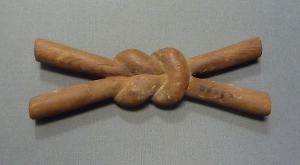 A knot amulet found at Hatshepsut’s mortuary temple
A knot amulet found at Hatshepsut’s mortuary templeIn addition to these four knots, another text talks about seven knots, or tesut, that were tied about the deceased to protect them.
The power of the magical knot is in its ability to both unite and “surround” things. The tied knot is a symbol of the coming together of two things in perfect wholeness, a condition that promotes a positive outcome.
A passage in the Coffin Texts says that when the hair of Isis is knotted to the hair of Nephthys, the Two River Banks (that is, the land of the living and the land of the dead) are united. Tying a knot could also refer to sexuality; the perfect coming together of two people in an act of creation. We still “tie the knot” when we get married.
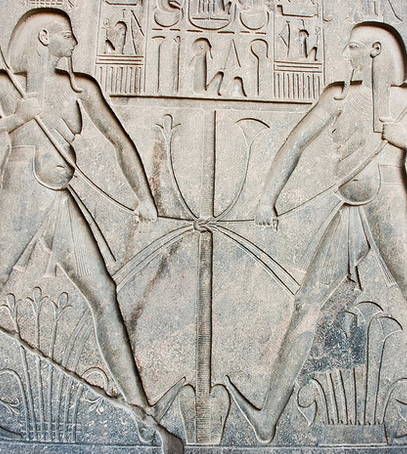 Hapi “tying the knot” to unite the Two Lands
Hapi “tying the knot” to unite the Two LandsFurthermore, because the two ends of the cord used in tying a magical knot symbolically go all the way around something, they “surrounded” that thing. Thus knot magic could thus be used to “surround” or “bind” an enemy—or even tie a curse to them.
In the Book of the Dead, formula 42 in Budge, the knot appears as a kind of seed. The deceased is said to be “the knot within the tamarisk tree, beautiful of splendor more than yesterday.” This surely refers to Osiris within the tree prior to His resurrection.
And, of course, the famous Knot of Isis is a magical knot. In most cases, it is protective and associated with renewal and resurrection. As time passed, it became a must-have amulet for all mummies and was usually placed on the upper torso.
In the ritual that follows, we are using the knots to surround with protection. We call upon Isis primarily, but also Nephthys, Neith, and Selket as the four Goddesses often found guarding the four corners of a shrine as well as the four Sons of Horus, Who in turn protect the canopic jars.
The Rite of the Tiet (the Knot of Isis)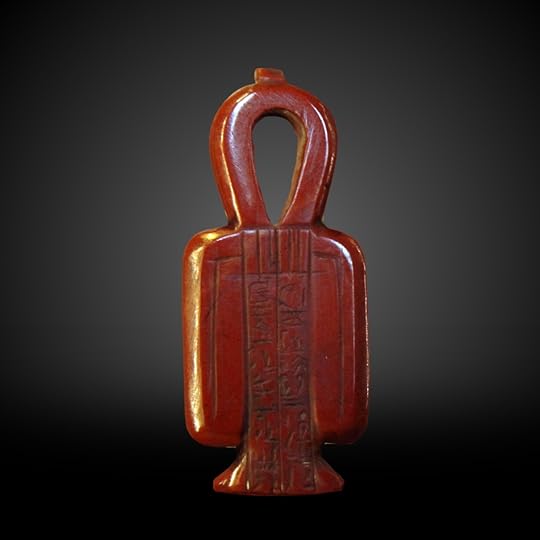 Isis protects!
Isis protects!About the Rite: In this rite, you will magically tie a protective knot around yourself (or around anything you wish to protect). The ritual draws upon sources in the Book of Coming Forth by Day and is, in part, adapted from an ancient rite for consecrating the Tet amulet.
Temple Arrangement: Altar at center; all tools on altar.
Ritual Tools: Nile water in Lotus Cup; petals from lotus, lily or rose flowers; Isis incense in censer; six pieces of fairly substantial red cord, each approximately one foot long (if you can’t find red cord that is thick enough, use white rope); Knot of Isis representation in any medium (if desired).
OpeningPurify and consecrate the temple and yourself according to the formulae of the House of Isis. Return to the altar, take up the lotus (lily or rose) petals and elevate them.
Ritualist: O, you Souls of Life, Lotus Dwellers, Breathers, you of the Pure Air from the Wings of Isis, I have come for you. By the Blood, by the Power, by the Magic of Isis, establish yourselves within these petals. (Vibrating onto petals) ISET NEF!
Place some of the petals in the chalice.
Ritualist: (Addressing petals) I know you, you shining flowers. Your name is “Life Is In It”. Your name is “Protection”. Your name is “Peace Bringer”.
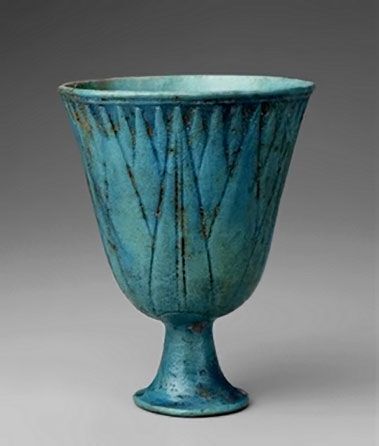 A beautiful Egyptian lotus cup
A beautiful Egyptian lotus cupPlace the pieces of red cord upon the altar and anoint each of them with the Nile water with flower petals in it.
Ritualist: (Touching each piece of cord) Isis protects!
Invocation of the Powers of IsisNext, invoke the Goddess, raising your arms in Adoration.
Ritualist: I call the power of my Mighty Mother Isis. I call Her strength to me. For I shall knot the cord, the Knot of Isis, and the power and peace of Isis.
O Isis, my Mother, I call You!
I call You with the breath of my body (breathing out).
I call You with the beat of my heart (touching chest).
I call You with the pulse of my life (touching wrists).
I call You with the words of my mouth (touching mouth).
I call You with the thoughts of my mind (touching forehead).
I call You Power. I call You Life. I call You Protection.
I call You, Isis!
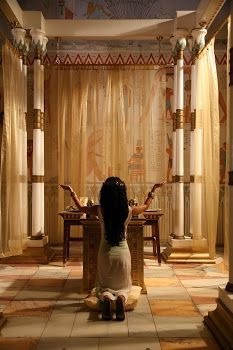 Tying the Knots
Tying the KnotsTake up one of the pieces of red cord and move to the southeast corner of the temple space. Holding the two ends of the cord in your hands, say:
Ritualist: You have Your Blood, O Isis. You have Your Power, O Isis. You have Your Magic, O Isis. The Blood of Isis and the Strength of Isis and the Words of Power of Isis shall be mighty to (state what you wish to protect) against all that would cause harm.
With strength and intention, tie a knot in the cord and set it in the southeast corner of the temple.
Ritualist: By the Power of Isis, I have knotted the cord.
Repeat this same procedure in the southwest, northwest, and northeast of the temple, above your head (leave the cord on the altar), and upon the ground (leave the cord at the foot of the altar).
Stand west of the altar, facing east. Make the Sign of the Wings of Isis.
Ritualist: O Isis and all You mighty Goddesses of Protection, I call upon You to guard (state what you wish to protect) as You did guard Osiris Himself, as You did guard Horus the Child.
Isis, Mighty Magician; Nephthys, Lady of Life; Neith, Primal Mother; Selket, Powerful One—tie the Knot of Isis against all harm. Keep it away! Restrain it! Let it not come near! O, Isis and all You Goddesses of Protection, grant Your peace and protection.
If you wish to meditate or do other work, this is an excellent time to do so.
 Isis Spreads Her Wings by Brandon Pilcher. See the work here.Closing
Isis Spreads Her Wings by Brandon Pilcher. See the work here.ClosingIf this is a ritual for protection from some outside threat, leave the tied knots in the temple for as long as desired or needed and conclude the rite by making the Sign of the Wings of Isis at the altar and speaking the last line.
If this rite was worked simply to create peace for meditation, you may untie the knots when you are finished by simply going to each knot in the order you tied it and untying it.
Ritualist: I have untied the knot. Be in peace, O You Blood and Power and Magic of Isis. Be in peace.
Take each piece of cord to the altar. [Skip to here if you are leaving the Knots tied.] At the altar, make Sign of the Wings of Isis.
Ritualist: I thank You, Isis, in all Thy names of Protection. Hold me ever near You, bound by Your protective knots.
Quit the temple.
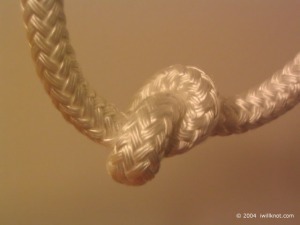 Use a simple, overhand knot in this ritual
Use a simple, overhand knot in this ritual
July 9, 2023
The Veil of Isis
 This work is by Ludovic Pinelli; you can purchase a print here.
This work is by Ludovic Pinelli; you can purchase a print here.To Isis, a Veil
En Iset, Behen
This is a gift I bring before Isis the Hidden One, Who, Revealing Herself, Shakes Destiny: an invocation offering of a veil.
For You, Isis, a hiding, a hint, a whisper, an obscuration, a veil.
From behind it, may You send revelations into my sleep. Dreaming, I understand the inner voice and vision; I coax truth from my heart. Yet upon waking, the veil is torn asunder and I only half remember that which was so potent while I lay beneath Your veil.
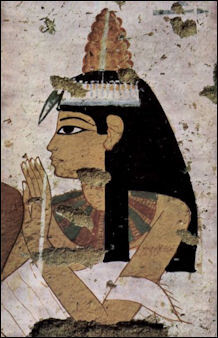 Egyptian woman with headdress
Egyptian woman with headdressO, but I adore Your mystery, Your obscurity, the crooked finger of Your concealing veil! Yes, Goddess, yes—veil Yourself in the depths of the indigo sky, in a blue-green blade of grass, in fire, in eyeshine in the darkness. For I could not bear the full brunt of Your beauty!
Draw me on with insinuations. Call to me with half-answered questions. Lead me with unknowns. And I shall ever follow, carrying the train of Your not-quite-translucent veil, hoping for another brief glimpse of You, beneath it.
Listen, O Isis, to the words of the Veil: “I am offered unto Isis as a kindness to mortals for I am their shield against the awe of the Goddess. Woven of darkness and daylight, the Cosmos itself is the loom upon which I was made. All things are connected to me in warp and woof. Tayet Herself, the Weaver, has made me, a perfect thing. I am the Uniting Mystery Never Quite Revealed. I am the Veil of Isis.”
Unto You, Isis, I offer this veil and all things beautiful and pure. M’den, Iset. Accept it, Isis.
The Veil of the Goddess
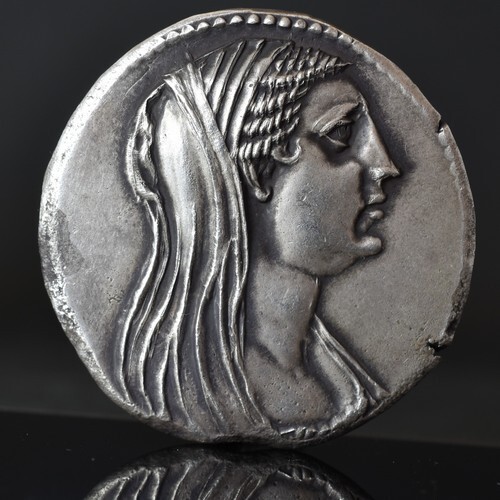 A coin with the image of Ptolemaic Queen Berenike II of Egypt with head veil
A coin with the image of Ptolemaic Queen Berenike II of Egypt with head veilThe phrase “the Veil of Isis” is so common that we might not question where it came from. But perhaps we should. For one thing, ancient Egyptian women generally weren’t veiled so it would be odd to see a Goddess depicted so. Oh, there were headdresses aplenty, but not concealing veils.*
By Ptolemaic times, under Greek influence, we do see veils as head coverings come into use, though they seem more decorative than anything else. Both Greek and Roman images of Isis often include a veil covering the back of the head and hair.
 Sais is a delta city
Sais is a delta cityThe phrase, Veil of Isis, comes to us from our Greek friend, Plutarch in his essay On Isis and Osiris. In it, he is talking about Egyptian Mysteries. He tells his readers that when the new pharaoh was crowned, he become privy to hidden Egyptian philosophy and notes that the Egyptians’ knowledge of their Deities “holds a mysterious wisdom.” To illustrate his point, he notes a certain seated statue of the Goddess of the Egyptian city of Sais. He says She is Athena “whom they [the Egyptians] consider to be Isis also.” She would, of course, be Neith, the Lady of Sais, Who was indeed assimilated to both Athena and Isis.
The statue bore an inscription: “I am all that was, and is, and shall be, and no mortal hath ever Me unveiled.” It speaks to the all-encompassing power and mystery of the Goddess.
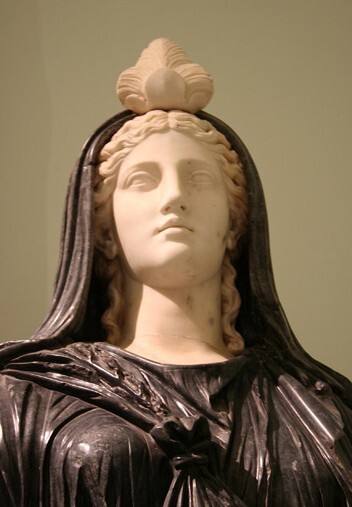 A Roman image of Isis, with veil
A Roman image of Isis, with veilIf there was such an image, we have not yet found it. Since Plutarch was writing in the 2nd century CE and the Ptolemies came in long before that, about 300 BCE, it is possible that the image of Neith-Athena-Isis could have been veiled—at least with the decorative-type veil we see in images of some Ptolemaic queens.
Proclus, a Greek philosopher writing in the 5th century CE, also quotes the inscription and adds another line: “The fruit that I have brought forth the Sun has generated.” He doesn’t mention Isis, but rather Neith-Athena and speaks in terms of the Goddess being involved in creation processes, both visible and invisible.
There are a few other ancient references to the veil of Isis. The Greco-Egyptian magical papyri refer to it on several occasions. In one, the magician invokes Isis and asks Her to remove Her veil in order to reveal the future and “shake destiny.” By revealing the Mysteries beneath Her veil, the magician hoped that the Goddess Who was worshiped as Lady of Fate and Fortune could not only predict, but could change or “shake” destiny.
 Science unveiling a multi-breasted Nature
Science unveiling a multi-breasted NatureEven after the end of the open worship of the Pagan Deities in the Mediterranean, Plutarch and other Greek philosophers continued to be studied. Because of Plutarch’s mention of the inscription in relation to Isis, the idea of the veil of Isis formulated more and more strongly and eventually passed into the annals of the Western Esoteric Tradition. The unveiling of the Goddess became a symbol of the revelation of esoteric secrets, sometimes specifically the revelation of Egyptian secrets.
European esotericists of many kinds came to use the metaphor of the Veil of Isis for the hiding or revealing of their own secrets. By this time, Isis was identified with the Goddess Nature, Who hides Her secrets from those who seek to understand Her.
This idea was particularly important to the alchemists who sought to uncover Nature’s secrets—She Who is Isis and Venus and Ephesian Artemis and the Anima Mundi (World Soul). Freemasons took up the idea of a veiled Isis keeping their own secrets and some even found Egyptian antecedents in their rituals.
 A French occult magazine titled the Veil of Isis
A French occult magazine titled the Veil of IsisThe Romantic movement, which rejected what they considered the coldness of the Enlightenment, preferring emotion and imagination, was also developing at this time. For Romantics, Isis’ veil concealed not just the scientific secrets of Nature, but a deeper, unexplainable Mystery that is, at the same time Ultimate Truth.
Philosophers took up the metaphor as well. Immanuel Kant said of the Saite inscription: “Perhaps no one has said anything more sublime, or expressed a thought more sublimely, than in that inscription on the temple of Isis (Mother Nature).” Influenced by Kant, the physician, playwright, poet, and philosopher Friedrich Schiller (what a guy!) tells a tale in which a young initiate rashly removes the Veil from a sacred image of Isis and is found nearly dead the next morning by the wiser priests; apparently, the secret was just too much for him.
Following in those mysterious footsteps, Helena Blavatsky’s 1877 book, Isis Unveiled, is a compendium of occult lore that purports to draw aside the veil of the Goddess for its readers. It continues to influence occultists to this day.
As a metaphor, the Veil of Isis was ubiquitous for centuries. Alchemists, magicians, freemasons, philosophers, scientists, poets, novelists, and visual artists all desired to life Isis’ Veil to discover the deepest secrets and truths, truths about Nature and truths about human beings in Nature.
This post barely scratches the surface of the many ways and places people were inspired by the veil of the Goddess. I’ve expressed some of my thoughts in the Offering at the beginning of this post. What is the Veil of Isis for you?
 “Isis, Goddess of Life” on the Herbert Hoover National Historic site. A gift of the people of Belgium in gratitude for Hoover’s famine relief efforts for them in WWI. Engraved on the statue, in French, is,” I am that which was and is and will ever be, and no mortal has yet lifted the veil that covers me.”
“Isis, Goddess of Life” on the Herbert Hoover National Historic site. A gift of the people of Belgium in gratitude for Hoover’s famine relief efforts for them in WWI. Engraved on the statue, in French, is,” I am that which was and is and will ever be, and no mortal has yet lifted the veil that covers me.”* It is possible to see the daily opening and closing of the shrines that held the sacred images of the Egyptian Deities as a kind of unveiling and veiling of the images.
July 2, 2023
Horus’ Twin Sister
I’m taking the holiday weekend off, so here’s a repost of what I think is an important connection.
Warning: this post refers to rape in myth.
 Boy and girl Divine Children, enwrapped in the protective coils of Isis-Thermouthis and Serapis Agathos Daimon
Boy and girl Divine Children, enwrapped in the protective coils of Isis-Thermouthis and Serapis Agathos DaimonDuring the excavation of Hathor’s temple at Denderah, an interesting statue, now in the Cairo Museum, came to light. It shows two children, one male, one female, standing within the protective coils of two serpents. On the boy’s head is a solar disk with an Eye of Horus on it. The girl has a lunar disk with an Eye of Horus.
The statue appears to be a votive gift, and may have originally come from the shrine of Isis-Thermouthis, believed to be not far from Denderah. According to experts, the serpents are most likely Isis-Thermouthis and Serapis Agathos Daimon.
 Isis as Agathe Tyche and Osiris as Agathos Daimon in serpent form
Isis as Agathe Tyche and Osiris as Agathos Daimon in serpent formIn the Ptolemaic period, Isis and Serapis/Osiris were frequently depicted as Divine Serpents. The Isis serpent can sometimes be the combined Goddesses Isis and Renenutet as Isis-Thermouthis. Other times, She can be Isis Agathe Tyche, Good Fortune. In both forms, She is partnered with Serapis/Osiris Agathos Daimon, or Good Spirit.
Unfortunately, there is no writing on the statue to help with the identification of the Divine Children. One possibility is that They are the well-known twins, Shu and Tefnut. There are things in myth and at the site that could support this interpretation. But as you might guess, I like a different possibility.
 Harpokrates with Mom Isis and Dad Serapis
Harpokrates with Mom Isis and Dad SerapisThe male child has the Horus lock, so He is probably Harpokrates, in Egyptian Hor-pa-khred, Horus the Child. Harpokrates was very popular during this time period. He is the child of Isis and Serapis and is frequently shown with a sun disk on His head. The fact that the Child God is protected by Isis and Osiris serpents, strengthens the identification. But if the boy is Harpokrates, Who is the little girl?
We don’t know of a twin sister of Harpokrates from either Egyptian or Greek sources. Some have wondered whether the lunar girl is supposed to be a form of Isis. Indeed Isis is called the Female Horus (Hor-et or Horit) in Egyptian sources. Several other Goddesses and a number of queens are called by the name as well. The Oxyrhynchus Hymn to Isis, written in Greek, calls Her Harpokratin, which is just Harpokrates with the Greek feminine ending. Translators have taken this to mean something like “the darling-girl of the Gods,” but it can just as easily be simply “Horet the [Girl] Child.” What’s more, by Ptolemaic times, Isis was indeed connected to the moon, even though She was not in earlier Egyptian sources.
Nevertheless, I stubbornly like the idea that the Divine Girl could be Horus’ twin sister, Horet. While this is the only statue we know of that shows the Harpokrates Twins together, during the Ptolemaic period, there are a few other baby girl statues that have been identified as Girl Harpokrates. We have no evidence of Her before this time, but we know that the Egyptians always did have a penchant for name-sharing male-female pairs of Deities, such as the Deities of the Ogdoad of Hermopolis.
 Horus or Horit? Love this image? Buy a copy from the artist here.
Horus or Horit? Love this image? Buy a copy from the artist here.Now, there is a Goddess Horit Who shows up in late Egyptian sources, specifically in what is known as the Delta Mythological Manual. Scholars aren’t sure where the manual came from, but they date it to about the 26th dynasty—though the material may be much older. It contains myths having to do with 12 of the nomes in the Egyptian delta. It could have come from a temple cache or been in the possession of a priest or maybe even a priestess. In this manual, we meet Horit. She is a daughter of Osiris, but we do not know Who Her mother is.
And…then things get bad.
You see, Horit bears sons fathered by Her father Osiris. The Delta Manual is pretty darned cryptic, but we learn that when Her father raped Her, it was Her “first time” and that when She learned She was pregnant, She “sat down and mourned.” What’s more, there was something wrong or unusual about the birth of the resulting child. The text isn’t super clear, but Horit may have either chosen abortion or miscarried. The child, being Divine, did not die, but instead left the premises immediately.
 Tefnut in Her lioness form
Tefnut in Her lioness formAfter this, Horit functions as a wife to Osiris and bears four more children, the last one after suffering a rape by Set. The manual (again very cryptically) tells stories about each of these sons of Horit—all forms of Horus. Strangely, there is even one called The Child of Isis. Of the third of these sons, the manual tells us that after Set murders Osiris, Horit raises Their son to be His father’s avenger; very Isis-like indeed. There is even an incident of decapitation just as there is in the story where Isis grants mercy to Set, which so enrages Horus (the two Gods are battling at the time) that He decapitates Isis, a state of affairs that wise Thoth fixes right away.
In the Delta Manual, the identities of all the Goddesses are very fluid; quite confusingly so. They are associated, joined, or become each other frequently. Horit is identified with Hathor and it is said that “She is the Divine hand of Re,” which is specifically a vagina. (In this version of the story, Re replaces Atum Who uses His Goddess-Hand to masturbate, producing Shu and Tefnut.)
 Tefnut is not happy
Tefnut is not happyMany of the myths in the Delta Manual, and most of Horit’s, have to do with boundary-crossing sex among Deities, consensual or not. In addition to Hathor, Horit is associated with Bast, Who is said to “come forth as Horit.” At Sebennytos and Behbeit (Isiopolis!), Horit is joined with Tefnut and the myth of the Raging/Distant/Returning Goddess (which is an important myth for another day). Sebennytos and Behbeit are in the 12th delta nome. There, the myths relate that Tefnut-Horit is raped by Her son Geb and imprisoned. The rapist is eventually punished and the Goddess freed, which becomes a cause for festival in the nome. So now, in addition to the rape of Horit the daughter by Her father Osiris, we also have the rape of Horit-Tefnut the mother by Her son. Some of you may know that there is similar tale in which Horus rapes His mother Isis and Her tears fall into the water.
WTF? Is it any wonder that Horit is among the raging Goddesses? And what the heck are we to supposed to make of all this anyway? We certainly do not approve. But neither did the ancient Egyptians. After all, Geb (and Set in other tales) is punished for His rape. And yet, the Egyptians retained these stories and, no doubt, tried to make sense of them.
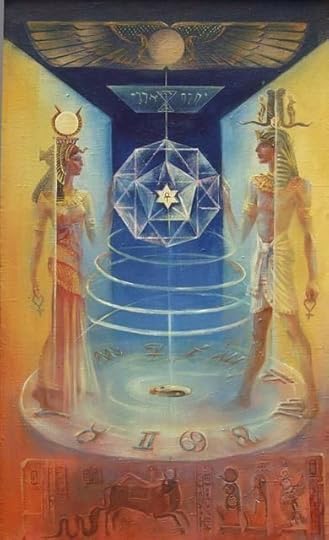 Goddess and Son? God and Daughter?
Goddess and Son? God and Daughter?I have speculated, in Isis Magic, about the possible meaning of the rape of Isis by Her son. It goes like this: What if that story, and others like it, are merely the very misunderstood remnants of a different and very ancient story; indeed, perhaps the oldest story? The Goddess Comes Into Being; of Herself, by Herself. She gives birth to a Child, a son. He grows to maturity. Then, in order to start the multiplication of life on earth, Divine Mother and Divine Son mate, not in a rape, but because They are All That Is. Could the same be said of the Divine Father and Divine Daughter? Obviously, I don’t know the answer to these questions. But it’s a way I can try to make it make some sense in my own head.
As for Harpokrates and His twin sister, I doubt we can make a direct connection between Horit and the Girl Harpokrates of the votive statue. And yet, and yet, and yet. Osiris has a son, Hor, and a daughter, Horit. (Different mothers? Same mother?) Hor and Horit make a perfect Egyptian name-sharing male-female pair. Horit’s myths come from the delta, including from Behbeit, where Isis’ great delta temple once stood.
I wonder whether we will some day find stories about Horit and Her mother? And if we do, what will Her name be?
June 25, 2023
Isis & Epona?
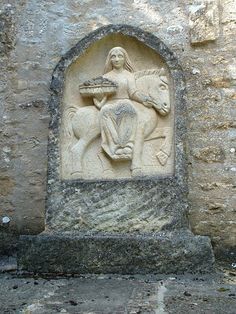 Epona on a horse carrying a basket of abundance
Epona on a horse carrying a basket of abundanceWell, this one is new to me.
And I always love, love, love it when I find out something new about Isis.
I found this ‘something new’ in an article about connections between Isis and the Celtic Horse Goddess Epona in Apuleius’ ancient tale known as The Golden Ass. (This is the one that has a fictionalized account of initiation into the Mysteries of Isis in the Greco-Roman world.) And I thought I’d share some of these possibilities with you.
 A lovely Epona in ‘Lady of the Beasts’ pose in Roman garb
A lovely Epona in ‘Lady of the Beasts’ pose in Roman garbNow I’m going to say right up front, I think the connections are fairly tenuous. Nonetheless, a professor of Classics (Jeffrey Winkle) wrote a whole article about it, so for me, it’s decidedly interesting enough to look into. What I think it boils down to is that many of the soldiers in the Roman Cavalry had a devotion to Isis—particularly as Isis-Fortuna and Isis the Savior because they were soldiers—and to the Goddess Epona—because they were in the cavalry and horses were vital to them. Very often, as we may experience in our own devotions, Deities can come together in our minds and hearts as we worship Them.
 Epona with Her many horses
Epona with Her many horsesNow, a note for those of you who have a devotion to Epona. I don’t know much about Her—and certainly not on an experiential level as you know Her—but I do understand that She is more than “just a horse Goddess.” All Deities are more than Their short-form definitions. More broadly, Epona the Great Mare, is a Goddess of Abundance and Her images often include cornucopias, sheaves of grain, along with newborn foals. Thus, like Isis, a couple other short-form definitions for Epona are Goddess of Fertility and Mother Goddess (She is often shown with the Matres).
 Demeter with Areion
Demeter with AreionThere is another fertility and motherly Goddess Who is a great mare: Demeter. One tale says that as Demeter is searching for Her daughter, Poseidon (short-form: Sea God, Earthquake God, and Horse God) becomes sexually obsessed with Her. She turns Herself into a great mare in an attempt to hide from Him, but He transforms into a great stallion and succeeds in raping the Goddess in this form. As a consequence, Demeter (now with the epithet Erinyes, “Fury”) gives birth to Areion, an immortal and heroic horse. Pausanias tells us of a sacred image of Demeter in Arcadia made with the head and hair of a horse. We already know how closely connected Isis and Demeter came to be in the Hellenic world; parts of Their myths become indistinguishable. An important Egyptian Goddess later syncretized with Isis, Hathor, is specifically called Mistress of Horses at Her temple at Denderah.
In addition to being Fertility and Mother Goddesses Epona and Isis (as well as Hathor and Demeter for that matter) also share an underworld connection. Epona sometimes carries a Hekate-like key to the underworld and She and Her horses can serve as psychopomps leading the souls of the dead into the afterlife. If you’ve been reading this blog, I certainly don’t have to tell you about Isis’ care for, protection of, and guiding of the dead.
 Isis Fortuna, with Her sistrum, and (possibly) Harpokrates riding a horse approaching
Isis Fortuna, with Her sistrum, and (possibly) Harpokrates riding a horse approachingSo, the slim threads of connection are there. Still, we don’t find images of Isis with a horse’s head, or in the form of a horse, or even riding a horse as we do Epona. The horse does make an appearance in Plutarch’s telling of the Isis and Osiris tale. When asked by Osiris which animal He thinks is the most useful for a soldier, Isis’ son Horus names the horse. And we do find late images of Horus, particularly as Harpokrates, riding on a horse. Isis Herself can also be broadly connected with the ass since it is one of the forms of Isis’ sibling Set. And hey, there is a modern racehorse named Isis, so there’s that.
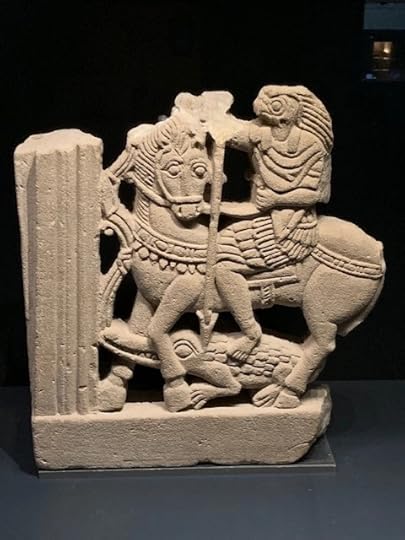 A grown Hapokrates riding a horse and subduing a crocodile
A grown Hapokrates riding a horse and subduing a crocodileIsis is further connected with the ass in Apuleius’ tale. And this is where the article I’m reading comes in. If you’re familiar with the story, you’ll know that the protagonist, Lucius, is accidentally turned into an ass by irresponsibly playing around with magic. Most of the story is about Lucius’ trials and tribulations as an ass. The denouement of the story is in its last book (we’d call it a chapter) when Lucius prays to the Moon Goddess for help and is answered by Queen Isis, Who is All Goddesses. She saves him from his asinine state, returning him to human form. He becomes initiated in Her Mysteries and is devoted to Her for the rest of his life.
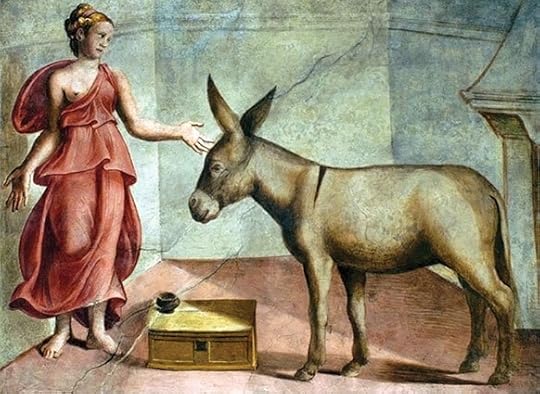 Lucius has become an ass
Lucius has become an assIt’s in all the books leading up to Lucius’ salvation by Isis that our professor looks for connections between Epona and Isis. Since Epona is protectress not only of horses, but of ponies (a small horse, not a young horse), mules (crossbreed of a horse and a donkey), donkeys (a domestic ass), and asses (a wild donkey), the ass-formed Lucius would easily come under Her purview. So what hints of Isis can we find in these other books?
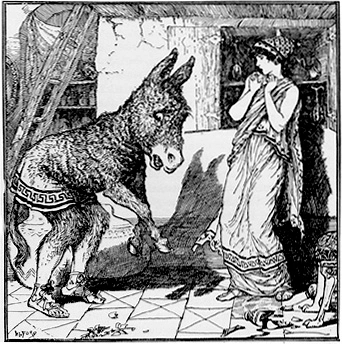 Lucius transforming into an ass
Lucius transforming into an assIn the very first line of the story, Lucius invites the reader to enjoy the tale as long as they “don’t object to reading Egyptian papyri, inscribed by a sly reed from the Nile.” As you might guess, this leads some researchers to scent a foreshadowing of Isis from the very start. Others have seen hints in the names of the Thessalian witches in one of the episodes in the story. They are Meroe and Panthia. Meroe is a Nubian city in which Isis was prominent and Panthia is close to Panthea, All Divine or All Goddess, a common epithet of Isis. But if they are supposed to hint at Isis, it must be as Her opposites, for the witches here are not the good guys.
Yet another researcher sees a prefiguration of Isis in the decorations of Lucius’ aunt’s home. The home’s atrium includes a statue of “a palm-bearing goddess, wings outspread” in each corner. Isis is indeed both winged and associated with the palm. Furthermore, we get Egyptian characters throughout the tale. In yet another episode, an Egyptian priest successfully raises a dead man to enable him to identify his murderer.
 A female figure on horse between two lares; is She Isis-Epona?
A female figure on horse between two lares; is She Isis-Epona?We first meet Epona once Lucius has been magically turned into an ass. Her sacred image is in the stable where Lucius spends the night awaiting the roses that will restore his humanity. Then he notices that Epona’s image is adorned with garlands of roses—exactly what he needs. Just as he is trying to reach them, a stable hand comes in and stops the uppity ass from toppling Epona’s image. A moment later, robbers break into the stable, steal the animals…and so Lucius’ adventures as an ass begin.
 A drawing of the same image so you can see it more clearly; I think the figure riding sidesaddle on the donkey is carrying a child in Her arms, strengthening the Isis connection
A drawing of the same image so you can see it more clearly; I think the figure riding sidesaddle on the donkey is carrying a child in Her arms, strengthening the Isis connectionHere we do have a parallel between Epona and Isis. Both Goddesses offer salvation with the aid of magically needful roses, which can be associated with both of Them. Lucius is foiled before he can eat the roses of restoration that adorn the image of Epona. It is only after many trials that Lucius finds Isis and She succeeds in providing the roses that enable him to become human once more. But should we take this as an equation of Epona and Isis? I don’t think so; yet we can know that Goddesses or THE Goddess is the means to Lucius’ salvation. The article aptly describes Lucius’ meeting with the two Goddesses as “bookending” his experiences. Lucius finds Epona just after he is transformed into an ass and he finds Isis before he can become human once more.
We do have an ancient text that specifically connects Isis and Epona—and with asses. It is from an early Christian making fun of the Pagan religions, so the remark is offensive. But the point isn’t the snark; it’s that he mentions both Goddesses in the same breath and connects both with asses. Here’s the quote:
Who is so stupid as to worship this kind of thing? Who is even more stupid so as to believe such a thing is worshiped? Unless, of course, you consecrate and decorate all the asses in your stables along with your—or rather their own—Epona and you reverently do the same to all your asses with Isis.
Minucius Felix, in Octavius
From Pompeii, we have a couple of frescos linking Isis and Epona. One of them (shown above), from a stable, shows a female figure riding a horse or donkey between two lares, household guardian spirits. Some scholars think the figure between them is Isis-Epona. Another, now lost except for a drawing of the original, shows Isis Fortuna on one side of the fresco with a horse-riding Goddess, most likely Epona , on the other. This particular image comes from a bakery, where donkeys would have been used to turn the flour mill. So here we have both Goddesses and an ass once again.
So there you have it. I’m not quite convinced that there ever was a syncretic Isis-Epona, but we can say that these two foreign-to-Rome Goddesses met up in a few places and certainly share in the sisterhood of Goddesses.
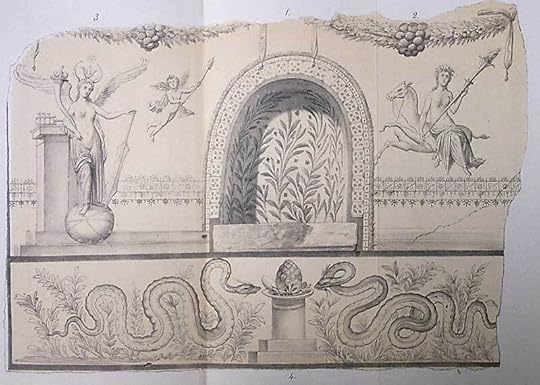 Isis-Fortuna on the left with typical headdress and sistrum (on the altar) with Epona riding a horse and carrying a torch on the right
Isis-Fortuna on the left with typical headdress and sistrum (on the altar) with Epona riding a horse and carrying a torch on the right
June 18, 2023
Iset Demdjet, Isis the Bone Collector
 Bone Woman, Crone Woman by Joan Riise. Find her work here.
Bone Woman, Crone Woman by Joan Riise. Find her work here.We know quite a lot about the history of the Great Goddess Isis. For instance, we know that She was already important by the time of the Pyramid Texts (Old Kingdom, 5th-6th dynasties). We know fairly clearly how Her worship spread throughout Egypt. We know how She came into Nubia and the Mediterranean. And we know how She went underground with the rise of Christianity in the Mediterranean and the West…staying alive in the magical traditions. Today there are few who do not at least know Her name.
Yet, what we don’t know for certain is where Her worship originated. So far, it is one of Her Mysteries.
Oh, there are theories. The one I am most seeing lately is that She is originally from some small city in the Egyptian delta of Lower Egypt. But strangely, no town in ancient Egypt, Upper or Lower, claimed to be Her “birthplace.” Since She became Egypt’s most famous Goddess, you would think someone would claim Her as their own.
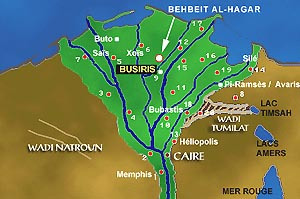 The Egyptian delta. The arrow points to the location of Isiopolis. You can see Heliopolis above Cairo (Caire).
The Egyptian delta. The arrow points to the location of Isiopolis. You can see Heliopolis above Cairo (Caire).Others attribute Upper Egyptian origins to Her, especially given Her important Upper Egyptian temple at Philae (now on Agilkia island). However, the oldest evidence we have of Isis worship on Philae is from the 26th dynasty.
On the other hand, the consensus of researchers today is that what would become ancient Egypt was first populated by Paleolithic people moving from south to north. So if proto-Isis was already known to these people, perhaps She did come from what would eventually be Upper Egypt. And Abydos, an important Osirian cult center, is in Upper Egypt.
On the other, other hand, Isis and Osiris are incorporated into the Heliopolitan myth cycle. And Heliopolis is about 20 miles north of Cairo and in the delta. What’s more, there was another famous Isis temple right there in the middle of the delta at Isiopolis. We may eventually find that it (or its predecessor on the site) is, in fact, the oldest temple of Isis. (Yes, of course, I asked Her. She told me, “delta.” But that is decidedly UPG, “unverified personal gnosis.”)
 Some very pretty skulls and bones from an Egyptian tomb
Some very pretty skulls and bones from an Egyptian tombI recently came across a paper by Dr. Kelly-Anne Diamond, an Egyptologist serving as Visiting Assistant Professor in the History Department at Villanova University, that makes a new and interesting contribution to the possible origins of Isis. She focuses in on the title of a female funerary ritualist. The title is “demdjet” and the demdjet can appear as a human ritualist, but also sometimes as a Divine ritualist. We find her—very infrequently—from the Old Kingdom to the New. Egyptologists used to group this particular ritualist under the general category of “mourning women,” but it appears the demdjet or Demdjet may have had a more specific function.
The root of the word has to do with collecting or assembling. And since the title is a feminine active participle, the title demdjet is “she who collects or assembles.” If you’re at all familiar with the ancient Egyptian funerary texts, you may recall that there is quite a lot of emphasis on making sure the deceased have all their bones, bits, limbs, heads, etc. collected or assembled for them as well as ensuring none of those things are disassembled or lost. Since Isis is the collector of bits and pieces par excellence—at least when it comes to Osiris (and thus the deceased)—Diamond suggests that this ritual role may play a part in Isis’ origins.
 The demdjet (top) and the kenut (bottom) offering nu pots
The demdjet (top) and the kenut (bottom) offering nu potsOne of the Pyramid Texts (PT 2283) refers to a Demdjet Vulture. It says, “Osiris Neith, accept Horus’ Eye, which Seth hid—THE HIDDEN VULTURE, which he joined—THE JOINED [Demdjet] VULTURE…” This Demdjet Vulture is involved with stretching or spreading something. We cannot say whether the Demdjet Vulture is supposed to be Isis, but at least we may have an early attestation of a Divine Demdjet. Of course, Isis can take vulture form, but it is not Her most common bird form. Yet, as a winged Goddess, She is often shown stretching or spreading Her wings over the deceased.
We also find the Demdjet in the pyramid temple of Senwosret III where She gives life and protection. From the Middle Kingdom, there are demdjets in the papyrus Ramesseum E. Some scholars think that the contents of that papyrus may date back to the 3rd dynasty (there are archaisms in the text). If true, it would be the oldest mention of a demdjet.
In this papyrus, we learn that the demdjets are present throughout the funerary rites. At some point, the demdjets move simultaneously, perhaps in ritual motion or dance. They are there when the deceased is summoned to revivification. And they have speaking parts. In the New Kingdom, we have several more instances of demdjets. They are shown as two kneeling women with nu water pots and they are watering “the desert necropolis.” In one case, one woman is labeled menkenu and one demdjet. (Alan Gardiner suggests menkenu is a title of Isis, while demdjet is a title of Nephthys.) In another case, one is called demdjet and one is called kenut (menkenu and kenut may be different versions of the same title).
 Same offering, different labels: The Great Kite and the Lesser Kite
Same offering, different labels: The Great Kite and the Lesser KiteBut here’s where it gets more interesting for Isiacs. In the last New Kingdom example (tomb of Paheri, if you must know), we find the same scene—women kneeling with nu pots, dressed in the same way—but this time, They are labeled Djeret Weret (Great Kite) and Djeret Nedjeset (Lesser Kite). In this time period, we know Who the Great Kite and the Lesser Kite are; They are Isis and Nephthys. So, the women depicted may be human ritualists portraying the Goddesses, which we know was done in Egyptian ritual. In additional—but very damaged—scenes in two of these tombs, we see the demdjet no longer kneeling, but standing with her/Her right arm raised, elbow bent, and fist clenched while her/Her left clenched fist is placed at her/Her chest. It reminds me of the henu gesture, but standing.
The henu gestureShe is labeled Djeret Weret Demdjet, the Great Kite Demdjet. The gesture s/She makes is thought to be associated with transfiguration, the recitation of holy words, and glorifications for the dead.
In the Book of the Amduat, a Goddess named Demdjet appears in the 7th and 8th Hours of the Night where She helps protect Re and the Sun Barque as it journeys through the Otherworld. In the 7th Hour, She is with three other Goddesses: She Who Cuts, She Who Punishes, and She Who Annihilates. In the 8th Hour, Demdjet is with three other mummiform Goddesses: She Who Veils, She Who Decorates (?), and the Dark One. Interestingly, the 7th Hour is the same Hour in which Isis and the Elder Magician work Their powerful magic to subdue Apophis. So in this case, with Isis in Her Great of Magic form, it seems to me it would be a bit of a stretch to consider this Demdjet, a minor Hours Goddess, to be a form of Isis.
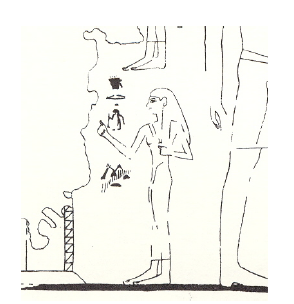 The Djeret Weret Demdjet making a gesture of transfiguration; we can see the feet of (probably) another demdjet (the Djeret Nedjeset Demdjet?) above this one, but this part of the tomb is damaged.
The Djeret Weret Demdjet making a gesture of transfiguration; we can see the feet of (probably) another demdjet (the Djeret Nedjeset Demdjet?) above this one, but this part of the tomb is damaged.Nevertheless, with its core meaning of She Who Collects, Assembles, and Puts Together, we can find in the Demdjet an important harmony with one aspect of Great Isis: She Who searches, finds, reassembles, and gives new life to Osiris.
Some researchers have suggested that there may have been a very early Egyptian funerary custom in which important dead persons were disarticulated and then put back together for rejuvenation. It’s a highly controversial topic, but if so, perhaps the original Demdjet may have been the female ritualist who did this reassembly. Perhaps she was serving as a priestess of the Great Renewing Mother. And perhaps, just perhaps, this Great Mother Regeneratrix was the Demdjet Weret—(proto) Iset Demdjet—She Who collects our bones for us that we may be made whole in preparation for our rebirth.



